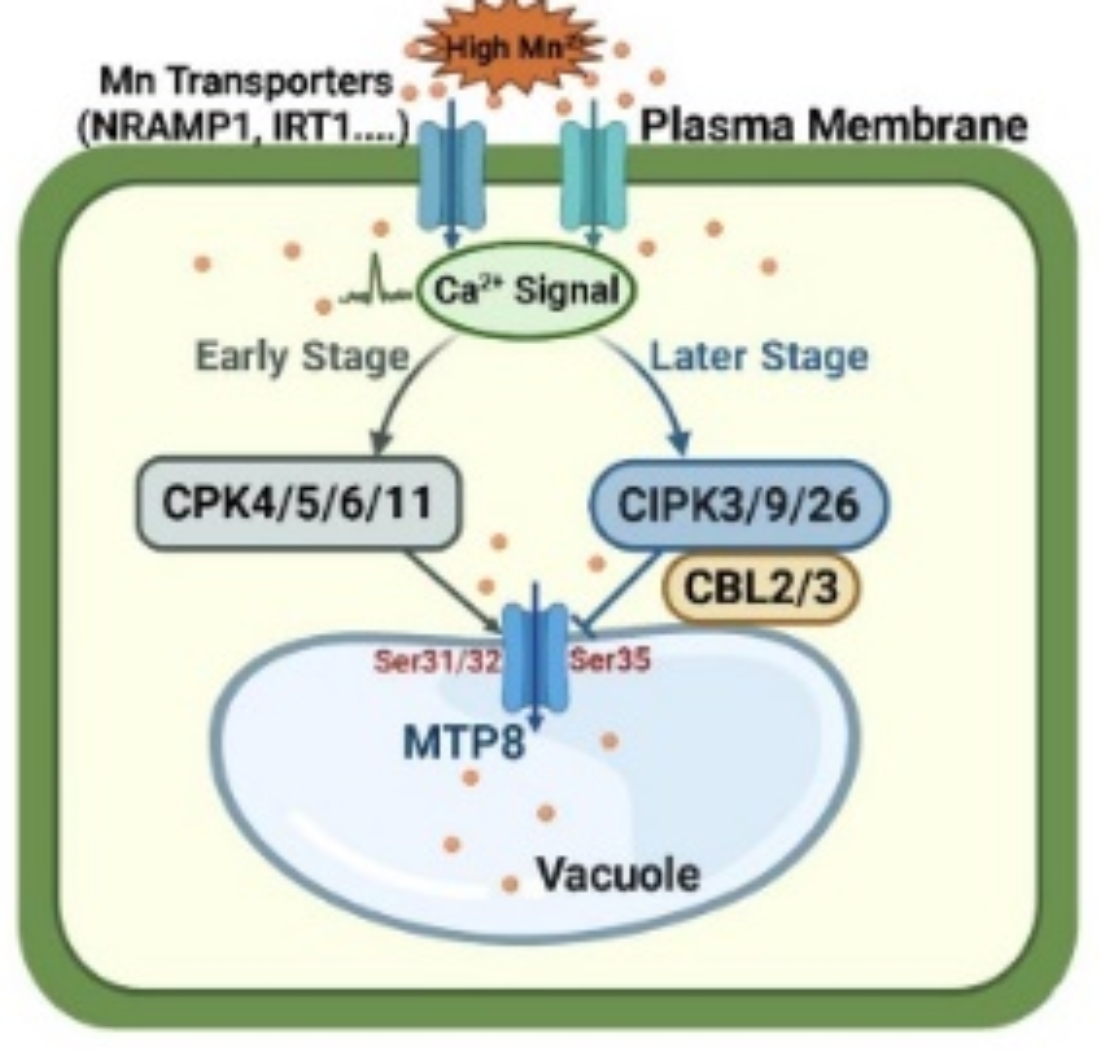王存等《Molecular Plant》2021年
论文题目:Ca2+-dependent successive phosphorylation of vacuolar transporter MTP8 by CBL2/3-CIPK3/9/26 and CPK5 contributes to manganese homeostasis in Arabidopsis
论文作者:ChuanfengJu#, Zhenqian Zhang#, Jinping Deng#, Cuicui Miao, Zhangqing Wang, Lukas Wallrad, LaibaJaved, Dali Fu, Ting Zhang,JörgKudla, Zhizhong Gong and Cun Wang
论文摘要:Manganese (Mn) is an essential micronutrient for all living organisms. However, excess supply of Mn as occurring in acid or waterlogged soils has toxic effects on plant physiology and development. Although a variety of Mn transporter families has been characterized, our understanding of how these transporters are regulated to uphold and adjust Mn homeostasis in plants remains rudimentary. Here, we identify two calcineurin-B-like proteins, CBL2/3, and their interacting kinases, CIPK3/9/26, as key regulators for plant Mn homeostasis. We found that Arabidopsis mutants lacking CBL2 and 3 or their interacting protein kinases CIPK3/9/26 exhibit remarkable high-Mn tolerance. Intriguingly, CIPK3/9/26 interact with and phosphorylate the tonoplast-localized Mn and iron (Fe)transporter MTP8 primarily at Ser35, which is conserved among MTP8 proteins from various species. Mn transport complementation assays in yeast combined with multiple physiological assays indicate that CBL-CIPK-mediated phosphorylation of MTP8 negatively regulates its transport activity from the cytoplasm to the vacuole. Moreover, we report that sequential phosphorylation of MTP8 initially at Ser31/32 by the calcium-dependent protein kinases CPK5 and subsequently by CIPK26 at Ser35 provides an activation/deactivation fine-tuning mechanism for differential Mn transport regulation. Collectively, our studies define a two-tiered calcium-controlled mechanism for dynamically orchestrating Mn homeostasis under conditions of fluctuating Mn supply.
锰是植物生长发育的必需微量元素,但酸性土壤和渍水土壤会对植物造成锰毒害。与其它微量元素相比,关于锰的吸收、转运和分配的调控机制还很不清楚。该研究最新发现,钙感受器cbl2/3以及其互作的蛋白激酶cipk3/9/26突变体对高锰胁迫显著耐受。重要的是,CIPK3/9/26与液泡膜定位的锰转运体MTP8物理互作,并磷酸化MTP8的第35位丝氨酸。酵母缺陷互补实验结合多种生理生化实验表明,CBL2/3-CIPK3/9/26介导的MTP8磷酸化抑制其转运活性。进一步通过体内磷酸化、磷酸化质谱等实验发现,CIPK3/9/26和CPK4/5/6/11对MTP8的磷酸化存在时间上的明显差异,并且不依赖于锰浓度的变化。酸性和渍水等土壤引起的高锰胁迫会激发植物Ca2+信号,CPK4/5/6/11磷酸化并激活MTP8,MTP8将细胞质中多余的锰离子隔离到液泡内,从而增加地下部锰含量,降低地上部锰含量,以保护植物避免高锰毒害。随后,植物为了实现生长和逆境的最佳平衡,CBL2/3招募CIPK3/9/26到液泡膜上并磷酸化MTP8,降低其活性以起到“刹车”的作用(图1)。该研究系统揭示了Ca2+-CBL2/3-CIPK3/9/26-MTP8信号通路与CPK4/5/6/11-MTP8分子模块拮抗调控植物锰稳态的分子机制。这种“加油/刹车”机制为植物逆境信号转导的解析提供了范式,并为培育有益重金属超富集作物和有毒重金属低积累品种提供了理论依据和技术支持。

图1 Ca2+信号精准调控植物锰稳态的模式图
西北农林科技大学生命科学学院博士生琚传凤,副教授张振乾以及中国农业大学博士生邓金萍为本文共同第一作者。西北农林科技大学生命科学学院王存教授为论文通讯作者。该论文得到了国家自然科学基金等项目的资助。
